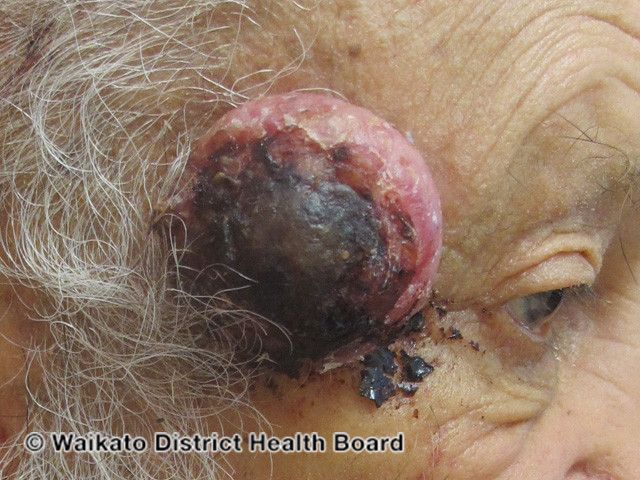- Acne
- Actinic Keratosis
- Aesthetics
- Alopecia
- Atopic Dermatitis
- Buy-and-Bill
- COVID-19
- Case-Based Roundtable
- Chronic Hand Eczema
- Chronic Spontaneous Urticaria
- Drug Watch
- Eczema
- General Dermatology
- Hidradenitis Suppurativa
- Melasma
- NP and PA
- Pediatric Dermatology
- Pigmentary Disorders
- Practice Management
- Precision Medicine and Biologics
- Prurigo Nodularis
- Psoriasis
- Psoriatic Arthritis
- Rare Disease
- Rosacea
- Skin Cancer
- Vitiligo
- Wound Care
News
Article
Mohs Surgery Improves Rates of Nodal Metastasis and Disease Specific Death in cSCC
Author(s):
Study results were presented at the 2023 American Society for Dermatologic Surgery Annual Meeting in Chicago, Illinois.
High-risk cutaneous squamous cell carcinoma
Image courtesy of the Waikato District Health Board and DermNetZ

A recent oral abstract presentation from the 2023 American Society for Dermatologic Surgery Annual Meeting in Chicago, Illinois, compared nodal metastasis and disease specific deaths in cutaneous squamous cell carcinoma (cSCC) between patients treated with Mohs micrographic surgery versus those treated with wide local excision. Isabella Camacho, MD, a postgraduate year 4 dermatology resident at MedStar Washington Hospital Center, presented the study results on behalf of her colleagues, Bo Kitrell and Ashley Wysong, MD, MS.1
Camacho et al used PubMed to search for articles focused on patient outcomes in cSCC published through June 20, 2023, using the keyword “cutaneous squamous cell carcinoma” combined with “outcomes,” “nodal metastasis,” “Brigham and Women’s Hospital,” and “American Joint Committee on Cancer.” Studies with solely immunosuppressed patients and cases in which staging, lymph node metastasis, and surgical treatment could not be identified, were excluded. In total, 9 studies were selected and reviewed, which included 4721 patients and 4747 tumors.
Out of the 9 studies, 4 studies included patients exclusively treated with Mohs micrographic surgery and 5 studies included patients exclusively treated with wide local excision.
Stratified by Brigham and Women’s Hospital (BWH) staging, patient outcomes in BWH T1 (0 high-risk factors) and T2a (1 high-risk factor) were not statistically significant. For BWH T2b (2 to 3 high-risk factors), both the nodal metastasis and disease specific death rates were significantly higher in the majority wide local excision group. Lastly, the disease specific death rates remained significantly higher at BWH T3 (≥ 4 high-risk factors).1,2
“Mohs micrographic surgery is a highly effective treatment modality for cutaneous squamous cell carcinoma, with improved rates of nodal metastasis and disease specific death, particularly in BWH stage T2b and T3,” concluded Camacho.
Disclosures
None relevant
Reference
- Camacho I, Kitrell B, Wysong A. Differences in modal metastasis in cutaneous squamous cell carcinoma with Mohs micrographic surgery versus wide local excision. Presented at: 2023 American Society for Dermatologic Surgery Annual Meeting; November 2-5, 2023; Chicago, IL.
- Stenger M. Brigham and Women’s Hospital tumor staging for cutaneous squamous cell carcinoma outperforms AJCC and UICC staging. The ASCO Post. March 15, 2014. Accessed November 3, 2023. https://ascopost.com/issues/march-15-2014/brigham-and-women-s-hospital-tumor-staging-for-cutaneous-squamous-cell-carcinoma-outperforms-ajcc-and-uicc-staging/
Newsletter
Like what you’re reading? Subscribe to Dermatology Times for weekly updates on therapies, innovations, and real-world practice tips.















